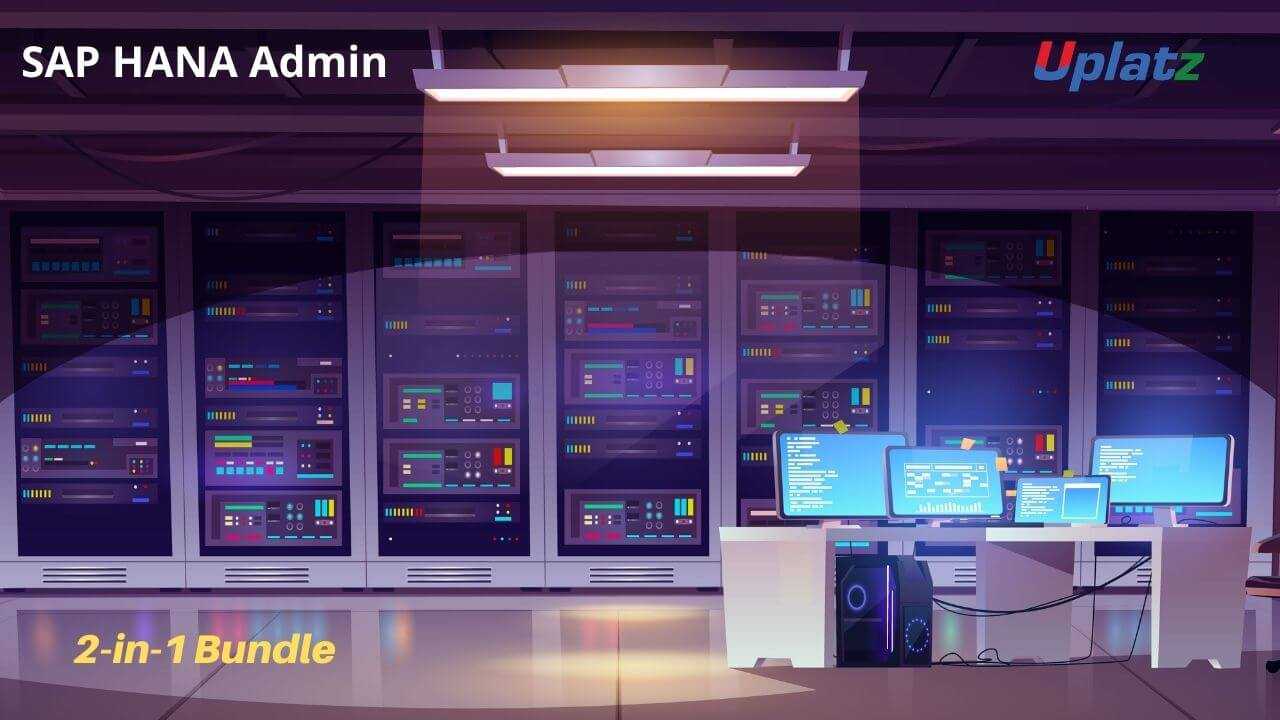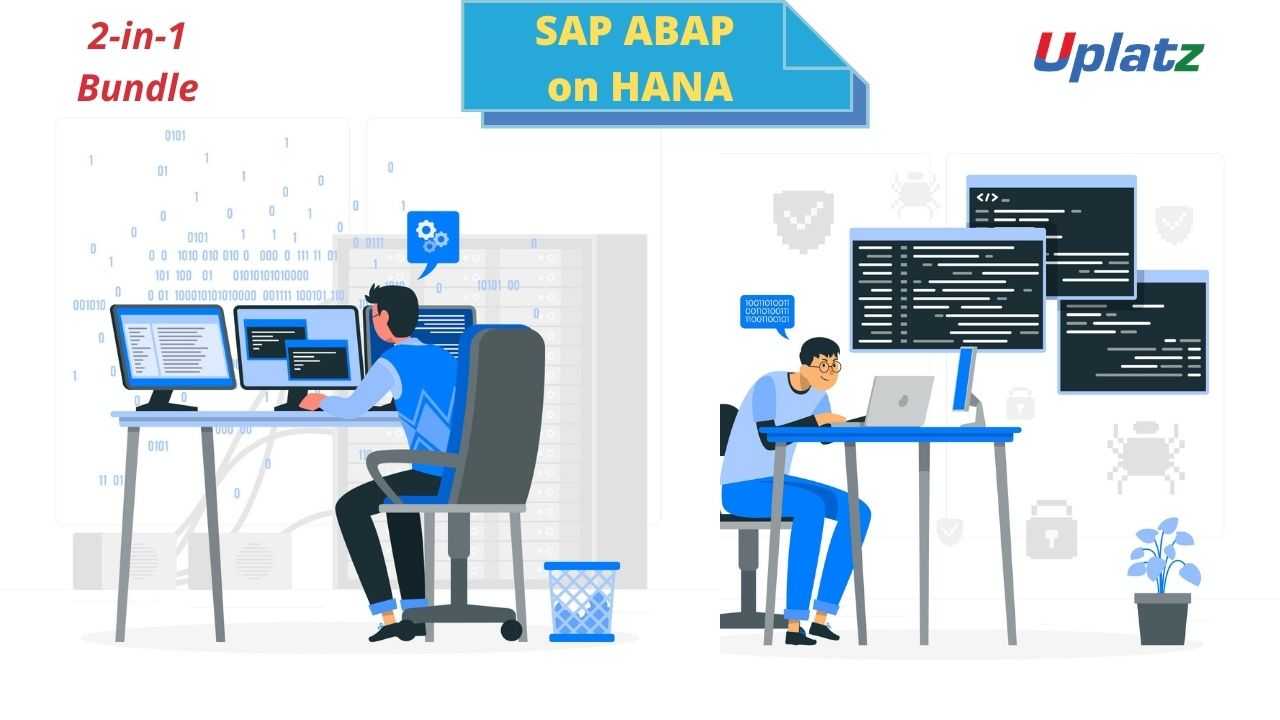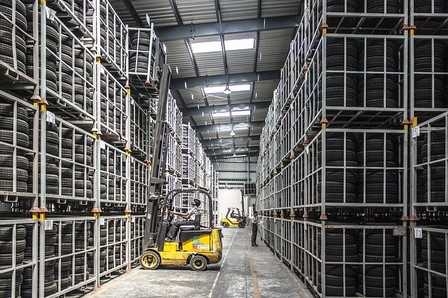Bundle Multi (2-in-1) - SAP HANA Admin
Learn details about SAP HANA Studio, automate OS scripts, command line admin tools, etc View Course Curriculum
Price Match Guarantee
Full Lifetime Access
Access on any Device
Technical Support
Secure Checkout
Course Completion Certificate
View Course Curriculum
Price Match Guarantee
Full Lifetime Access
Access on any Device
Technical Support
Secure Checkout
Course Completion Certificate
 85% Started a new career
BUY THIS COURSE (
85% Started a new career
BUY THIS COURSE (GBP 22 GBP 49 )-
 94% Got a pay increase and promotion
94% Got a pay increase and promotion
Students also bought -
-

- Bundle Multi (2-in-1) - SAP ABAP on HANA
- 40 Hours
- GBP 22
- 315 Learners
-

- Bundle Course - SAP BO and SAP BODS
- 50 Hours
- GBP 22
- 548 Learners
-

- SAP EWM (Extended Warehouse Management)
- 22 Hours
- GBP 12
- 826 Learners

This is the Bundle Multi (2-in-1) – SAP HANA Admin course by Uplatz consisting of self-paced training (pre-recorded videos) on SAP HANA Administration. These are two complete sets of courses from different tutors covering each topic of SAP HANA Administration in detail.
1.SAP HANA Admin
SAP HANA is an in-memory database for performing real-time data analysis, and improvement of applications on the top of real-time data. HANA administration deals with managing SAP HANA system in a single and distributed system environment. SAP HANA is a game changing product from SAP that provides in-memory database for performing real-time data analysis and development of applications on top of data. HANA helps companies solve data, reporting, latency challenges and unleash their potential with a real time platform.
SAP HANA features a cloud-based functioning, it works in real time and SAP HANA supports multiple isolated databases (multitenant database containers) in a single SAP HANA system.
SAP HANA Administration includes the following activities −
1).SAP HANA multiple host system management
2).SAP HANA Administration Tools
3).SAP HANA System Management and Availability
4).SAP HANA Lifecycle Management
5).SAP HANA Security and User Management
6).SAP HANA Backup and Recovery Management
7).SAP HANA Data Provisioning and Integration with non-SAP systems
In this Bundle Multi (2 in 1) SAP HANA Admin course by Uplatz, you will learn to install, configure, operate and administer a SAP HANA Landscape. The course starts with the Introduction and then moves to the Installation, Configuration, Management, and Update of SAP HANA system.
Then you will get to know the administration tools and how to configure the db. In this SAP HANA Admin course, you will learn how to administer, perform standard administrator tasks, setup end to end security and understand how to setup HA and DR. Towards the end we see back-up and recovery.
The SAP HANA administration course will provide you detailed knowledge of SAP HANA administration tools, security and user management, system management and availability, data provisioning and integration with non-SAP systems and more. You will deploy SAP HANA Studio, automate through OS scripts, command line admin tools through hands-on projects and case studies.
Course/Topic 1 - SAP HANA Admin - all lectures
-
In this first video on SAP HANA Admin tutorial, you will get a brief introduction to what is SAP HANA, what is HANA database, how HANA overcomes the daily irritations like the sub-optimal execution speed, lack of transparency, reactivate business model, how HANA database is much more useful than the normal database and many more. You will also learn about the SAP HANA deployment view, the component Architecture view, the HANA individual components, a pictorial diagram showing the example of Deployment Landscape, and many more.
-
This video is about the installation of SAP HANA, starting with the SAP HANA Sizing, Main Memory Sizing, Disk Sizing, CPU Sizing, what is SAP Quicksizer, what are the requirements for the SAP HANA Single-Host and Multi-Host Database System, the basic components of the SAP HANA system, the installation of single and multiple-SID and lastly the Operating System and Hardware Requirements. Further, you will be learning about the important directories and their sizes and finally the File System Structure for a Multi-SID Installation.
-
This video is a tutorial on the SAP HANA appliance and the sizing of the components. You will get a practical demonstration on how to show certified SAP HANA appliance configurations throughout the session.
-
This tutorial will explain to you the various Lifecycle Management tools for installing SAP HANA starting with a brief introduction to SAP HANA Lifecycle Management Tools, explaining various installation methods, how to install SAP HANA as a single-host, installing and configuring SAP HANA Studio, installing the SAP HANA SHINE content and lastly, explaining a multi-host system installation.
-
This session is an exercise on installing your own standalone SAP HANA System. You will be shown the complete process during the session and lastly, how to update the SAP HANA Studio using an Update Site.
-
This session will teach you about the post-installation steps, updating SAP HANA, the revision strategy of SAP HANA and SHINE; SAP HANA Interactive Education. Here the target audience is taken as the System Administrator.
-
In this tutorial, you will learn how to update SAP HANA with a new support package along with installing the SAP HANA Interactive Education (SHINE) content. The complete and step-by-step work process will be shown throughout the session.
-
In this session, you will learn about the SAP HANA Memory Management and Data Persistence, Software Packaging, SAP HANA Roadmap and Scenarios, and the Deployment Options. Here, the target audience is the System Administrator and the complete session will be shown with a detailed explanation in a step-by-step procedure.
-
This tutorial will explain to you the different admin tools for the SAP HANA, starting with a detailed explanation on the Overview of Administration Tool, the SAP HANA Studio and SAP HANA Cockpit, the DBA Cockpit, and lastly, the HDBSQL Command Line Tool.
-
In this tutorial, you will learn about the process of starting and stopping SAP HANA, the configurations steps involved in SAP HANA, the SAP HANA Table Administration, the Periodic Tasks and the process of Transporting Changes.
-
This practice session is an exercise on the process of starting and stopping SAP HANA. You will learn the complete process of how to do it in the SAP system.
-
In this video, you will learn about the concept of Backup and Recovery, the Data Area Backup, Log Area Backup along with some additional Backup topics. You will also learn about the Recovery process, the Backup, and Recovery using Storage Snapshot, and the Database Copy.
-
This video is an exercise session on the Backup and Recovery process where you will get a complete and step-by-step explanation of the whole work process in the SAP System.
-
In this session, you will learn about the Monitoring and Troubleshooting steps involved in SAP HANA, starting with Configuring Traces, working with Diagnosis Information and Diagnosis Files, SQL Console, and Query Analysis. You will also be learning about the Monitoring with SAP Solution Manager, Remote Support, and lastly the SAP Early Watch Alert.
-
This video will show you the complete work process of how to configure SAP HANA Traces. You will learn each and every step of it during the session.
-
In this video, you will get a complete overview of the Security involved in SAP HANA along with Authentication and Authorization, encryption, and lastly the Auditing.
-
In this session, you will learn about User Management, the types of Privileges, Roles, Administrative Tasks, the information Sources of Administrators, and lastly the SAP HANA Live Authorization Assistant.
-
This video is an exercise session on Maintaining Users and Authorization in the SAP HANA system. You will be getting a detailed workaround of the entire procedure in the SAP system.
-
In this video, you will get the knowledge on the concepts like High Availability and Disaster Tolerance, starting with the Continuous Availability and then moving forward towards High Availability, the SAP HANA Scale Out and lastly the Disaster Recovery.
-
In this video, you will learn a complete step-by-step procedure of the installation of the SAP HANA Scale Out System and the whole work process associated with it.
-
This video will teach you about the Multitenant Database Containers starting with the Architecture and Technology of it, the Administration of Multitenant Database Containers, the Backup and Recovery of Multitenant Database Containers, and lastly the Appendix.
-
This last video is a post-assessment session where you will be asked some questions and based on that, your knowledge of the subject will be measured. The assessment will cover modules like SAP HANA Introduction, Installation and Post Installation, Architecture and Scenarios, Admin Tools for SAP HANA, Operations, Backup and Recovery, Monitoring and Troubleshooting, Security, Maintaining Users and Authorization and lastly about the High Availability and Disaster Tolerance.
You will learn about;
a).Multiple host system management
b).Administration Tools
c).Management and Availability
d).Lifecycle Management
e).Security and User Management
f).Backup and Recovery Management
g).Data Provisioning and Integration with non-SAP systems
This course provides a comprehensive introduction to SAP HANA administration, focusing on installation, configuration, monitoring, and troubleshooting of SAP HANA systems. Participants will learn essential administrative tasks to manage and optimize SAP HANA databases effectively.
Part 1: Introduction to SAP HANA
Week 1: Overview of SAP HANA
a) Introduction to SAP HANA and its architecture
b) Key components and features of SAP HANA
c) Understanding in-memory computing and its advantages
d) Course objectives and structure
Week 2: SAP HANA Installation and Configuration
a) Pre-requisites for installing SAP HANA
b) Installation procedures for SAP HANA on different platforms
c) Configuration of HANA system parameters
d) Hands-on exercise: Installing and configuring SAP HANA
Week 3: User and Security Management
a) Overview of user management in SAP HANA
b) Creating and managing users, roles, and privileges
c) Implementing security best practices in SAP HANA
d) Hands-on exercise: Setting up user roles and permissions
Week 4: Data Modeling in SAP HANA
a) Introduction to data modeling concepts
b) Creating and managing calculation views and attribute views
c) Using the SAP HANA Studio for modeling tasks
d) Hands-on exercise: Building basic data models in SAP HANA
Part 2: Administration and Performance Management
Week 5: Database Backup and Recovery
a) Understanding backup types: full, incremental, and differential
b) Implementing backup strategies for SAP HANA
c) Restoring and recovering HANA databases
d) Hands-on exercise: Performing backups and restores
Week 6: Monitoring SAP HANA Systems
a) Overview of monitoring tools and techniques
b) Using SAP HANA Studio and SAP HANA Cockpit for monitoring
c) Key metrics and alerts for performance management
d) Hands-on exercise: Setting up monitoring and analyzing performance metrics
Week 7: Performance Tuning and Optimization
a) Identifying performance bottlenecks in SAP HANA
b) Techniques for optimizing queries and data models
c) Best practices for performance tuning
d) Hands-on exercise: Conducting performance analysis and optimizations
Part 3: Advanced Administration and Capstone Project
Week 8: Troubleshooting SAP HANA
a) Common issues and troubleshooting techniques
b) Using SAP HANA logs and traces for diagnostics
c) Strategies for resolving system errors
d) Hands-on exercise: Troubleshooting scenarios in SAP HANA
Week 9: Advanced Features in SAP HANA
a) Introduction to advanced data provisioning methods
b) Overview of Smart Data Integration (SDI) and Smart Data Access (SDA)
c) Implementing high availability and disaster recovery solutions
d) Hands-on exercise: Setting up high availability in SAP HANA
Week 10: Capstone Project
a) Overview of capstone project objectives
b) Participants will design and implement a comprehensive SAP HANA administration solution
c) Presentation of projects and peer reviews
d) Discussion on challenges faced and lessons learned
Recommended Resources:
Textbooks:
1)"SAP HANA Administration" by A. K. Jain and P. S. H. S. Thakkar
2)"SAP HANA: An Introduction" by Dr. B. J. S. Kumar
Online Resources:
1) SAP Learning Hub for online training modules
2) SAP Community for support and discussions
Tools:
1) SAP HANA Studio and SAP HANA Cockpit for hands-on practice
Assessment:
1) Weekly quizzes and assignments
2) Mid-term project focused on specific SAP HANA administration tasks
3)Final capstone project showcasing a complete SAP HANA administration solution
The Machine Learning with Python Certification ensures you know planning, production and measurement techniques needed to stand out from the competition.
SAP HANA is an in-memory database for performing real-time data analysis, and development of applications on top of real-time data. HANA administration deals with managing SAP HANA systems in a single and distributed system environment.
SAP HANA is an in-memory data platform that is deployable as an on-premise appliance, or in the cloud. It is a revolutionary platform, which is best suited for performing real-time analytics, and developing and deploying real-time applications.
Candidates studying for a specialist certification need to pass two exams: one on the associate level and another for the specialty. To take the exam, candidates need to go to SAP's website and purchase a voucher. Then, SAP offers three main locations for the exam: SAP Training Center, Pearson VUE, or in the cloud.
Uplatz online training guarantees the participants to successfully go through the Machine Learning with Python certification provided by Uplatz. Uplatz provides appropriate teaching and expertise training to equip the participants for implementing the learnt concepts in an organization.
Course Completion Certificate will be awarded by Uplatz upon successful completion of the Machine Learning with Python online course
The SAP HANA Admin draws an average salary of $96,080 per year depending on their knowledge and hands-on experience. The SAP HANA Admin job roles are in high demand and make a rewarding career.
SAP certification is an excellent career option for those candidates who dream to become a successful SAP HANA consultant. There is no doubt that SAP HANA job offers complete job satisfaction with a greater salary range.
In the present job market, the SAP HANA experts are in high demand. Well, there are only some professionals who meet the needs of the SAP HANA requirements. As SAP HANA is the most challenging and demanding technology today, the SAP HANA professionals can get the average salary in the range of $51,994 – $145,093.
Note that salaries are generally higher at large companies rather than small ones. Your salary will also differ based on the market you work in.
Q1.Mention what’s SAP HANA?
Ans:SAP HANA stands for top Performance Analytical Appliance- in-memory computing engine. HANA is connected to ERP systems; Frontend modeling studios are often used for replication server management and cargo management. (sap Hana admin interview questions)
Q2.Mention the 2 sorts of relative knowledge keep in HANA?
Ans:The two sorts of relative knowledge keep in HANA includes
a) Row Store
b) Column Store
Q3. Mention what’s modeling studio?
Ans:Declares that tables area unit keep in HANA, 1st half is to urge the meta-data and so schedule knowledge replication jobs.Manage knowledge Services to enter the info from SAP Business Warehouse and different systems.Manage ERP instances affiliation, this unleashes doesn’t support connecting to many ERP instances.Use knowledge services for the modeling
Do modeling in HANA itself.essential licenses for SAP BO knowledge services
Q4. Mention what area unit the various compression techniques?
Ans:There are unit 3 totally different compression techniques
a) Run-length encryption
b) Cluster encryption
c) Dictionary encryption
Q5. Mention what’s latency?
Ans:Latency is said the length of your time to copy knowledge from the supply system to the target system.
Q6. justify what’s transformation rules?
Ans:The transformation rule is that the rule laid out in the advanced replication setting group action for the supply table specified knowledge is remodeled throughout the replication method.
Q7. Mention what’s the advantage of SLT replication?
Ans:It allows a period of time knowledge replication, replicating solely connected knowledge into HANA from non-SAP and SAP supply systemsIt is totally integrated with HANA studios,Replication from many supply systems to 1 HANA system is allowed, additionally from one supply system to multiple HANA systems is allowed.
Q8. justify however you’ll avoid unnecessary data from being stored?
Ans:To avoid unnecessary data from being kept, you have got to pause the replication by stopping the scheme-related jobs (sap Hana admin interview questions)
Q9. what’s the role of the master controller job in SAP HANA?
Ans:The job is organized on demand and is accountable for Creating info triggers and worktable into the supply systemCreating Synonyms
Q10.justify what happens if the replication is suspended for an extended amount of your time or system outage of SLT or HANA system?
Ans:If the replication is suspended for an extended amount of your time, the dimensions of the work tables will increase.









